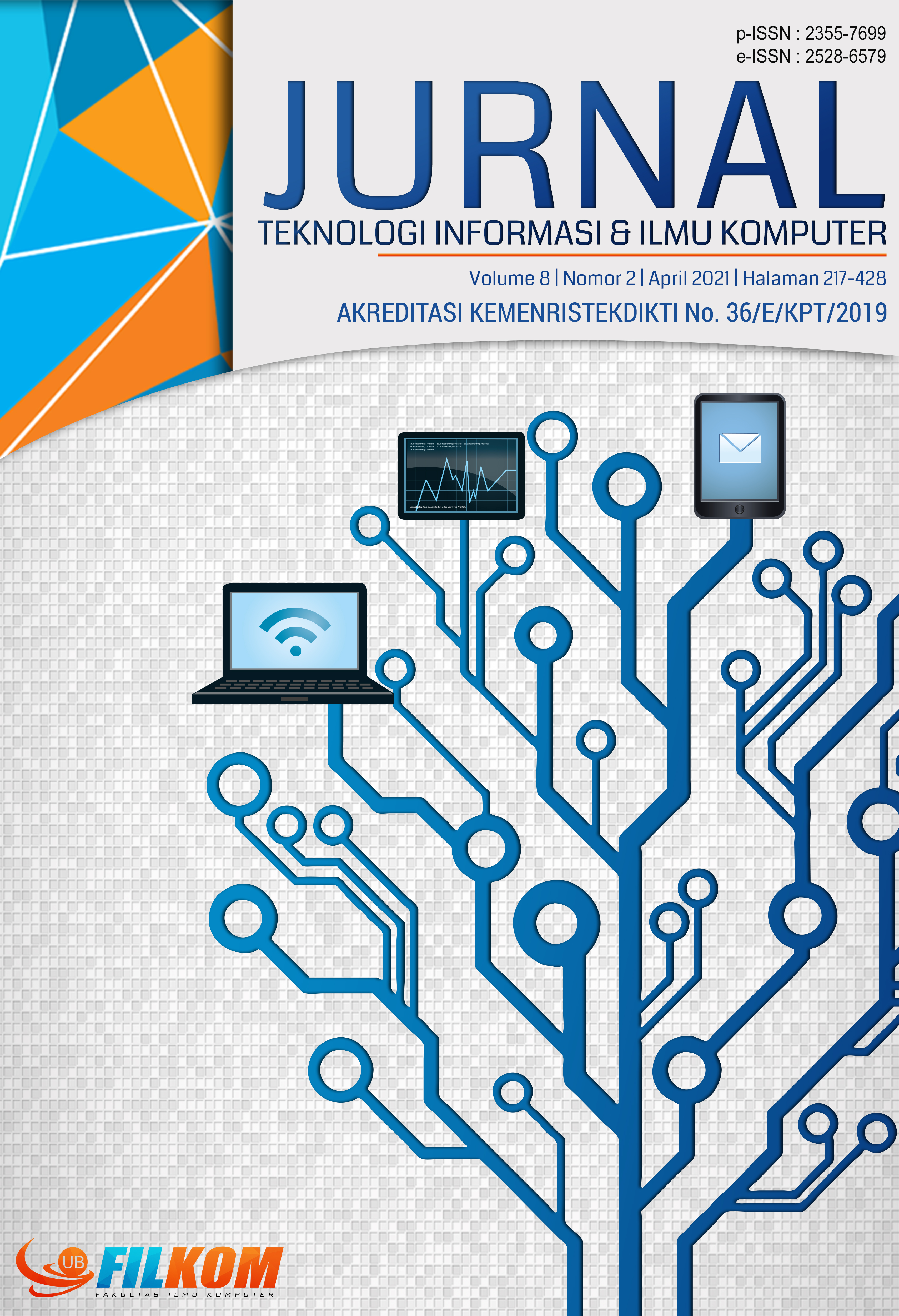Evaluasi dan Redesign Website Pendidikan Tinggi dengan Menerapkan User Experience Lifecycle
DOI:
https://doi.org/10.25126/jtiik.2021824367Abstrak
Pada awalnya perguruan tinggi membuat situs web untuk mengenalkan dan mempromosikan lembaga pendidikannya. Diresmikannya Undang-Undang Nomor 14 Tahun 2008 tentang Keterbukaan Informasi Publik (UU KIP) dan Undang-Undang Nomor 25 Tahun 2009 tentang Pelayanan Publik (UU PP) menciptakan suatu keputusan di mana badan publik wajib “meningkatkan pengelolaan dan pelayanan informasi di lingkungan badan publik untuk menghasilkan layanan informasi yang berkualitas”. Penelitian yang bertujuan untuk meningkatkan kualitas situs web ITK dan mengecilkan tanggapan kurang baik yang diberikan mahasiswa ITK dilakukan dengan cara melakukan evaluasi dan redesign pada situs web ITK guna memperbaiki kualitas situs web ITK dan juga untuk mengurangi permasalahan yang di alami pengguna situs web ITK. Digunakan metode User Experience Lifecycle Template pada penelitian ini dikarenakan metode ini dapat digunakan untuk mengembangkan suatu produk (Prototype, Hardware, dan Software). Adapun hasil yang didapat pada penelitian kali ini ialah, pada aspek learnability meningkat 2x lebih cepat dibandingkan situs web ITK yang lama, lalu pada aspek efficiency didapat persentase pengguna mencapai tujuannya dalam menggunakan situs web ITK yang baru sebesar 94.40%, lalu pada aspek memorability jumlah klik mengalami penurunan pada situs web ITK yang baru jika dibandingkan dengan web ITK yang lama, dan pada aspek eror yang akan terjadi pada situs web ITK yang baru bernilai 1.61% kemungkinan.
Abstract
At first, the college created a website to introduce and promote its educational institutions. The establishment of Law No. 14 the year 2008 on Public Information Disclosure (KIP Law) and Law No. 25 of 2009 on public services (ACT PP) creates a decision where public bodies are obliged to "improve the management and information services in the public agency to produce quality information services". The research aimed at improving the quality of the ITK website and discouraging the poor responses given by ITK students are conducted by evaluating and redesign the ITK website to improve the quality of ITK's website and also to reduce the problems that are in the user's natural ITK website. Used method User Experience Lifecycle Template in this research because this method can be used to develop a product (Prototype, Hardware, and Software). As for the results gained on the research this time is, on the aspects of learnability increased 2x faster than the old ITK website, then on the efficiency aspect gained the percentage of users reached its goal in using the new ITK website 94.40%, then on the memorability aspect of the number of clicks decreased on the new ITK website when compared to the old web ITK, and on the aspect of the error that will happen to the new ITK Web site worth 1.61% of the probability.
Downloads
Referensi
ARIKUNTO, S., 2006. Prosedur penelitian : suatu pendekatan praktek. Jakarta: Rineka Cipta.
BANK, C., 2014. Web UI Design Best Practices. California, USA: UXPin.
GOODMAN, E., KUNIAVSKY, M. & MOED, A., 2012. Observing the User Experience. 2nd penyunt. USA: Elsevier,Inc.
MORVILLE, P. & ROSENFELD, L., 2007. Information Architecture for the World Wide Web. 3rd penyunt. USA: O’Reilly Media, Inc.
NASUTION, S., 2006. Metode Penelitian Naturalistik-kualittaif. Bandung: Tarsito.
NIELSEN, J., 1995. 10 Usability Heuristics for User Interface Design.. s.l.:s.n.
POLANCIK, G., 2009. Empirical Research Method Poster.
PRAMONO, W. A., AZ-ZAHRA, H. M. & ROKHMAWATI, R. I., 2019. Evaluasi Usability pada Aplikasi MyTelkomsel dengan Menggunakan Metode Usability Testing. Volume 3.
PREECE, J., Y VONNE, R. & SHARP, H., 2002. Interaction design : beyond humancomputer interaction. 4th penyunt. New York: Jhon Wiley & Sons, Inc.
REX, H. & PARDHA, P., 2012. The UX Book: Process and guidelines for ensuring a quality user experience. USA: Morgan Kaufmann.
SUGIYONO, P. D., 2011. Metode Penelitian Kuantitatif, Kualitatif, dan R&D. XIII penyunt. Bandung: Alfabeta.
SULISTIYONO, M., 2017. EVALUASI HEURISTIC SISTEM INFORMASI PELAPORAN KERUSAKAN LABORATORIUM UNIVERSITAS AMIKOM YOGYAKARTA. DATA MANAJEMEN DAN TEKNOLOGI INFORMASI, Volume 18, pp. 37-43.
TOMLIN, W. C., 2018. UX Optimization: Combining Behavioral UX and Usability Testing Data to. Texas: Apress Media LLC.
YUMARLIN, M., 2016. Evaluasi Penggunaan Website Universitas Janabadra dengan Menggunakan Metode Usability Testing. Jurnal Informasi Interaktif, Volume 1, pp. 35-43.
Unduhan
Diterbitkan
Terbitan
Bagian
Lisensi

Artikel ini berlisensi Creative Common Attribution-ShareAlike 4.0 International (CC BY-SA 4.0)
Penulis yang menerbitkan di jurnal ini menyetujui ketentuan berikut:
- Penulis menyimpan hak cipta dan memberikan jurnal hak penerbitan pertama naskah secara simultan dengan lisensi di bawah Creative Common Attribution-ShareAlike 4.0 International (CC BY-SA 4.0) yang mengizinkan orang lain untuk berbagi pekerjaan dengan sebuah pernyataan kepenulisan pekerjaan dan penerbitan awal di jurnal ini.
- Penulis bisa memasukkan ke dalam penyusunan kontraktual tambahan terpisah untuk distribusi non ekslusif versi kaya terbitan jurnal (contoh: mempostingnya ke repositori institusional atau menerbitkannya dalam sebuah buku), dengan pengakuan penerbitan awalnya di jurnal ini.
- Penulis diizinkan dan didorong untuk mem-posting karya mereka online (contoh: di repositori institusional atau di website mereka) sebelum dan selama proses penyerahan, karena dapat mengarahkan ke pertukaran produktif, seperti halnya sitiran yang lebih awal dan lebih hebat dari karya yang diterbitkan. (Lihat Efek Akses Terbuka).















